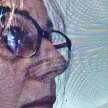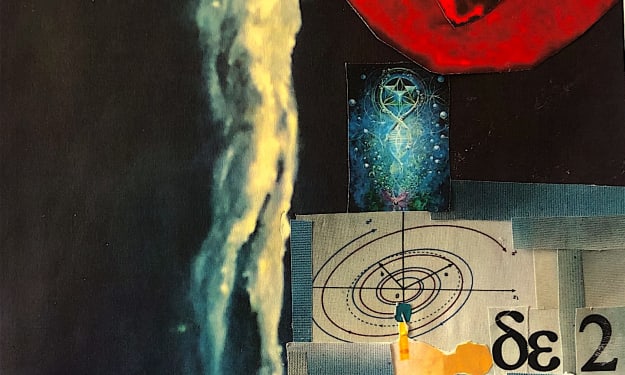
"Nobody can hear a scream in the vacuum of space, or so they say. However, we can feel the echos whisper.” Robert murmured these words to Kat as they were laying on the star-gazer lounges, under the August evening sky, looking at the Perseids meteors flying past. He added, “It's a shame that the full moon has washed out most of the meteors. We'll have to wait till next year to see the full glory of the ice, rock and dust debris from the Comet Swift-Tuttle go by.”
Kat said, “Who knows what next year will bring.” She caught a sob and transformed it into a query. “I wonder if our grandchildren will be able to see the Comet when it comes in 100 years, and for that matter, I wonder if our grandchildren will be able to learn these stars from wherever they are settled?”
Robert respected her emotional control as he spoke. “Heaven knows it won’t be for lack of trying. Mark and Evi will be doing their best to pass on knowledge to those who are willing to learn. They are both smarter and more informed than we ever were. They have explored ancient myths and mastered current theories of the stars and planets. They are committed to ensure this knowledge is not lost. We have done our best to prepare Evi to be independent and realize herself while at the same time, contribute to the world. She and Mark have found each other and they are a great pair. They really complete each other. We have done our job well. We are not the first generation whose kids have left the nest.”
Kat sighed, “Robert, I'm sure other parents felt like this in the past when their kids left home and they thought they would never see them again. But we know the risk is so much greater with them going into space. Twenty years ago, I would never have believed that space travel would have accelerated as quickly as it has."
“Man’s search for power, through money or resources, and their quest to look for adventure really does turn the cranks of what is called progress” replied Robert. “Since 2001, rich Russian moguls with deep pockets have explored the frontiers of space, looking to invest in space tourism. In 2022, NASA joined them establishing that tourists could perform experiments. The profits helped pay for the space elevator. Realistically, space travel has always been a contingency plan in the event of global destruction. But I have to agree with you, at this time in history, space travel holds many uncertainties that we can fixate upon if we allow ourselves to do so. But to what end?
"I am proud that our daughter and son-in-law have been invited to be part of the founder community as one the first new satellite extraterrestrial residents. As Ex Terras, they will be building a new foundation for humans to make the leap from the Earth. Time has shown we cannot sustain populations above those from the pre-industrial era.
"Albeit, it does seem bizarre that all their education and work will be used to create the carnivalesque reality that will attract the tourists who might choose to be future settlers. They are the floor models on show to set the next new trend, mannequins on display as ambassadors who represent what humanity can be and do when they work together. The irony is that they have been selected from thousands and are anything but the norm.”
Kat sighed, “True enough, but they do blend in well! The reality is that this just isn’t a short-term visit for our kids. Who knows if we will ever see them again? Thank heavens we will have satellite communication, but who knows for how long.”
Robert held her. “Honey, calm down. It’s a case of us or them going first. This way, at least we are sharing the grief instead of having it be one-sided.”
“God you are a morbid one” chuckled Kat. She continued, "Did I tell you that Evi says her imagination is being pushed to the limit preparing lessons? I think she is in her glory. She and Mark are being pushed hard and seem to be handling it well.”
Robert nodded. “I am looking forward to hearing about the programs she and Mark are developing." Robert was a founder of the theories that promoted the concept of ‘the No final goodbye program’ based on a concept everlasting lambda - a long waves that can self-propagate and form solitons, that are applied to high speed technologies and Mach capabilities in optical and sound systems that were being applied to matter.
Robert had exposed Evi to the language of science in the context of astro-mythological-history throughout her life. Evi said she had learned quantum physics through osmosis. She had naturally followed in footsteps of her parents to acquire skills that she could share. Mark, on the other hand, had consciously left this parent's trade in finance and chosen his path studying in the field of quantum physics.
Mark had met Evi in the integrated studies educators program. It was as if a current of electricity had been activated and drew them together. Their partnership was a marriage of souls. Both were looking to realize their potential and apply it to reduce the problems of the current global crises and help what they found the best of humanity survive. They functioned independently yet in a way that complimented each other’s skill set.
During classes, they had quickly been identified as exceptional. They were already a couple when they were invited to work together as curriculum designers for the Ministry of Restructuring in the Nouvelle Vague. The new vague was the term given to the wave of social changes that held undefined forces that were typical in this era of Quantum revolution. Mark and Evi were part of the Soliton Solutions Division, that supported the sustainable wave packet that could resonate a pulse and generate Mach capabilities.
Mark and Evi had watched enough Star Trek to be seduced into accepting the position as coordinators of education for the Ex Terra settlements that were being established on satellite communities around the space station and on explorer missions. They had just completed the challenges of the first stage of preparation, living and working in the underground biosphere. They designed and delivered programs adapted to the unique challenges of artificial light, humidity and temperature conditions. Along with medical, psychological, nutrition and emotional support teams, they established coping strategies to ensure they could meet the mandates of the enormous task they were undertaking.
The learning curve was steep. They identified ways to minimize the effects of not seeing or accessing external space and sunlight and had established significant improvements in student performance with incentives. The data and results of effective teamwork, at both student and organizer levels, had resulted in them moving to Stage two that had brought them to the underwater habitat. It was far more challenging. The environment instilled the feeling of space sickness that they would experience on the satellite that was to be tethered to the International Space Station.
Now, they were in Stage three, on the first tethered satellite. Thanks to Disney, tourism in Japan, China and the US, had created sufficient profits to fund the 220-mile-high entry into the atmosphere. This reduced the cost of fuel needed to escape gravity making the second half of the journey to the ISS affordable. From the ISS, space elevators made of graphene ropes would connect a pod of portables along elevator shafts that were eventually going to extend 100,000- kilometre back to the Earth.
Recruitment into the program had formalized for Evi and Mark, that they saw eye to eye on most things. They had arrived on the satellite pod a week before the students. “God, I fear horrid,” said Evi. “You’re not alone,” said Mark. “We’ve got to make things a bit easier until the kids acclimatize to this feeling.”
The planning teams faced physical, social and emotional challenges in designing habitats that could double the current global population. Evi and Marc were selected to design a common curriculum that would address the mandates of the international charter that would address the human tendency to cling to traditional habits. They also were to encourage the “founder effect” that would result in each pod's developing their own customs and language. The educational curriculum was uniform throughout each pod, however, the manner in which each culture utilized the knowledge was unique.
Their aim was to guide and direct the interests of students on the Satellite pods so as to nurture their dispositions as they were completing preliminary apprenticeship training of their parent's careers. Like all members of the crew, the job came at a price. There was a commitment that each family recruited to construct and maintain the project would train their offspring as apprentices who would learn the trade of their parents.
The world was regressing. However, identifying the predisposition to skills and abilities was considered a better option than state-controlled reproduction of humans as drones. The incentive was that upon a successful ranking at the completion of modules, the student and the family could visit or chose to move to another pod. If at age 16 a student chose to pursue a different avenue that that of their parents, upon completion of the modules, they could decide how they wished to be prepared in order to contribute to the community with or without their family. Humanity was being given a chance to redeem itself from simply exploiting the next generations as slaves to problems inherited by the past.
The course of history had changed but humanity had not kept up with the accelerating changes as population growth exceeded intellectual growth. Evi and Marc approached the design of the integrated curriculum on the Ex Terra settlements to approach issues with how hierarchical dominance and exploitation could upset the balance. The survival of humanity was at stake and the threat of annihilation was real.
Mark and Evi were prepared to give students experiences that would direct them on how not to repeat some of the mistakes made throughout history. Using broad strokes, they hoped to benefit from the great flood by technology that had swept the globe. Myths from most cultures held the same foundations, the problem was to motivate the students to accept the challenge to hold onto foundations and ride the rip current taking them from stable ground or be prepared for the foundations to be destroyed if they got swept into a whirlpool and rebuild them. The discovery of the soliton offered a model that reinforced that idea that sound foundations arise on their own.
Mark and Evi needed to integrate various perspectives to strengthen the movement through the quasistationary states along the superconducting path of the quantum soliton. The ideals of harmony within one self and a changing environment were lovey, but they were uncertain if any skills could compensate for aggression, competition and exploitation caused by ignorance, insecurities and the need for immediate gratification.
As was often the case, in a world where individuals had opportunities to be anything within their potential, many people are afraid to be themselves. It was not clear if this was the result of a genetic predisposition unleashed by environmental conditions or a lack of training. That answer would never be clear. All they could do was offer students experiences to build up confidence that they held the potential of control.
Mark and Evi had to use remote learning experiences that facilitated them working together. Algorithms identified students strengths to determine the weak influences between students who were strangers to each other. As randomly assigned teams completed learning modules, the results were collated to determine the influence of each individual on innovating and encouraging others to complete the task as a team. Students were assigned standings and matched with potential partners.
The results were positive. As hoped for, natural leaders were emerging and with them their followers. The leaders were able to navigate as others contributed to find the way. Each earned mutual respect for the other as influencers who could support the New Wave. Those who could work with and include the lone roamers, who could not or chose not to work within the usual parameters, had the best results.
The quantum soliton offered an intuitive understanding of dynamics through weak interactions. The quantum world was resilient. Inclusion and integration could transform the long-lasting dark and bright waves of force, so that it could remain intact even without atoms. It self-propagated through the force of interacting quantum systems when dissonance was integrated into the whole.
Understanding the quantum world affected the psychological state of the students. They were more willing to apply themselves without fear or threat that results in submission or domination and eventual annihilation. The fate of humanity depended on each individual meeting the potential of their individual worth and as part of a team. Students learning about the soliton as an energy conduit in the resonant lattice could enter and exit the soliton as a team in a breath that could utilize their combined force to direct collisions that hit at the center of potential. Each matter-wave soliton breath, that was within magnetic quench limits, could satisfy needs at all quantum levels and extinguish problems without annihilation.
Mark and Evi were left with finding ways for the students of the next generation to share the same breath.
About the Creator
Katherine D. Graham
My stories are intended to teach facts, supported by science as we know it. Science often reflects myths. Both can help survival in an ever-changing world.






Comments
There are no comments for this story
Be the first to respond and start the conversation.